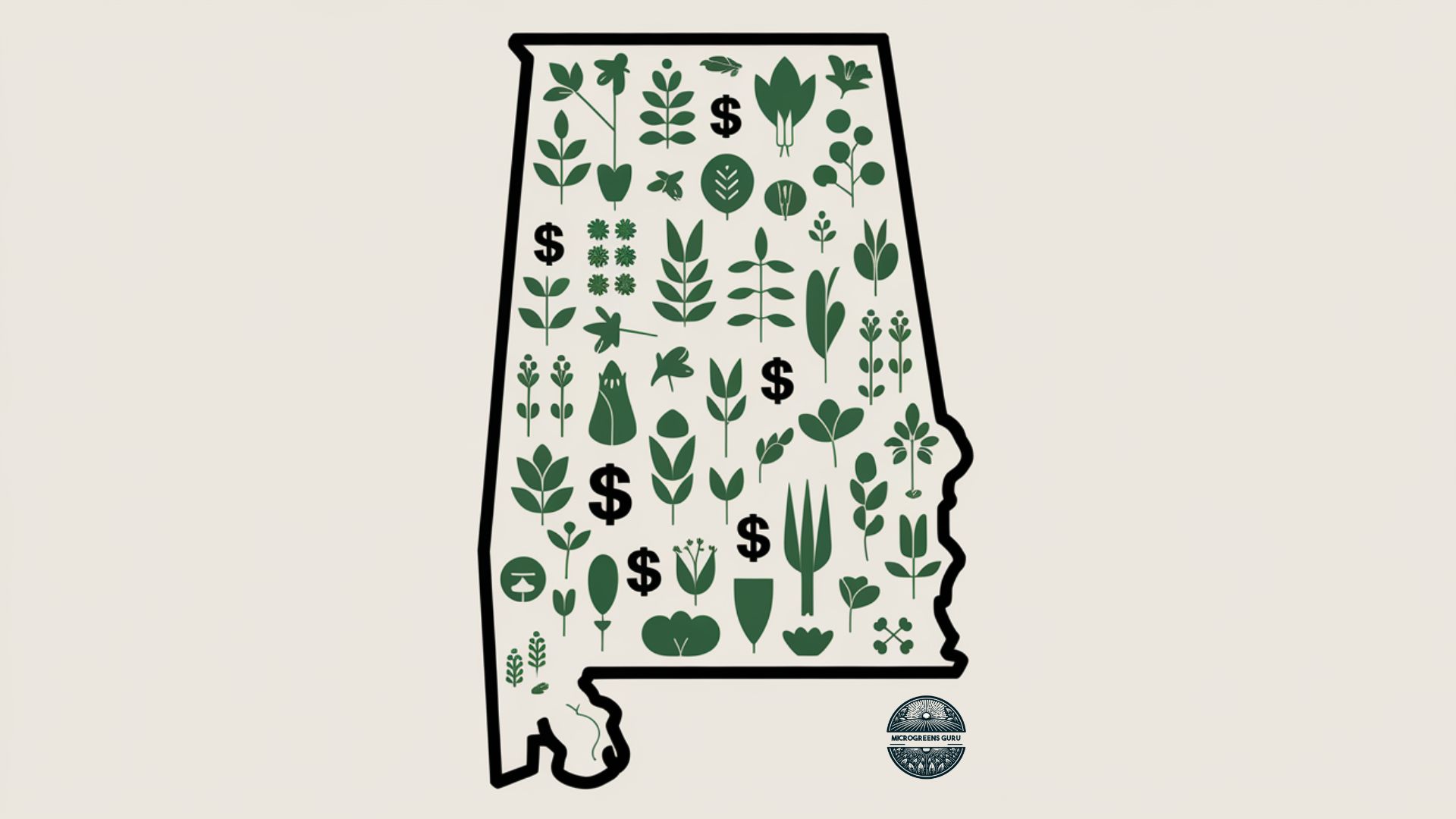Grow Your Green Business: A Guide to Selling Microgreens in Alabama
Some of our posts on Microgreensguru.com contain affiliate links. If you click on an affiliate link and make a purchase, we may receive a commission. Clicking on an affiliate link that earns a commission does NOT result in additional charges or costs you extra. Earnings from affiliate links help keep this website running. See our full affiliate disclosure here.
Have you ever considered turning your passion for gardening into a thriving business in the Heart of Dixie?
Selling microgreens in Alabama offers a unique opportunity for green-thumbed entrepreneurs to tap into a growing market. These nutrient-packed powerhouses have been taking the culinary world by storm, and Alabama’s rich agricultural heritage provides fertile ground for this innovative venture.
From bustling farmers markets in Birmingham to high-end restaurants in Mobile, the demand for fresh, locally-grown microgreens is on the rise.
As a microgreens enthusiast with years of experience, I’ve seen firsthand how these tiny greens can make a big impact on both plate and profit.
Whether you’re a seasoned gardener looking to diversify or a budding entrepreneur seeking a niche, the world of microgreens in Alabama is ripe with potential.
Let’s explore how you can cultivate success in this exciting field, navigating the unique challenges and opportunities that the Alabama market presents.
Key Aspects of Selling Microgreens in Alabama
Climate-suitable varieties like radish, sunflower, and pea shoots thrive in Alabama’s warm climate.
Understand and comply with Alabama’s cottage food laws and licensing requirements for selling microgreens.
Explore diverse sales channels including farmers markets, restaurants, and online platforms for maximum reach.
Leverage local resources and support networks to grow your microgreens business in Alabama.
Key Takeaways
Before we dive into the details, here are the essential points to remember about selling microgreens in Alabama:
- Alabama’s climate is suitable for year-round microgreens production
- Different regulations apply to small growers and commercial outlets
- Cottage food laws may apply to some microgreen operations
- Proper labeling and packaging are crucial for compliance and marketing
- Local resources are available to support microgreens growers in Alabama
- The microgreens market in Alabama is growing, offering opportunities for entrepreneurs
- Understanding your target market is crucial for success
- Continuous learning and adaptation are key in this evolving industry
Best Microgreens to Grow in Alabama
Alabama’s unique climate offers both opportunities and challenges for microgreens growers. Understanding which varieties thrive in our state is crucial for your success. Let’s explore some of the top performers and why they work well in Alabama’s environment.
Climate-Suitable Varieties
Alabama’s warm, humid climate is ideal for growing a variety of microgreens. Some top performers include:
- Radish microgreens: These spicy little greens thrive in Alabama’s climate and are ready to harvest in just 5-7 days. They’re heat-tolerant and grow quickly, making them perfect for our long, warm seasons.
- Sunflower microgreens: With their nutty flavor and hearty texture, sunflower microgreens are a customer favorite. They’re relatively heat-tolerant and can be grown year-round in Alabama with proper management.
- Pea shoots: These sweet, tender greens are perfect for Alabama’s cooler seasons. They can be grown outdoors in spring and fall, or year-round in controlled environments.
- Broccoli microgreens: Packed with nutrients and mild in flavor, broccoli microgreens are versatile and popular. They prefer cooler temperatures, making them ideal for fall and winter production in Alabama.
- Amaranth microgreens: These colorful greens add a visual pop to any dish and grow well in Alabama’s warm weather. They’re heat-tolerant and can be grown throughout our long growing season.

Popular Microgreens Among Alabama Consumers
While growing climate-suitable varieties is important, it’s equally crucial to understand what Alabama consumers are looking for. Here are some insights into popular microgreens in our state:
- Basil microgreens: With Alabama’s love for Southern and Italian cuisine, basil microgreens are in high demand. They offer a burst of flavor that complements many local dishes.
- Cilantro microgreens: As the Hispanic population in Alabama grows, so does the demand for cilantro microgreens. They’re popular in Mexican and Tex-Mex cuisine, which is gaining traction across the state.
- Mustard microgreens: These spicy greens appeal to Alabamians who enjoy a bit of heat in their meals. They’re often used in Southern-style dishes and salads.
- Beet microgreens: With their vibrant color and earthy flavor, beet microgreens are popular among chefs and home cooks alike. They add a gourmet touch to many dishes.
- Arugula microgreens: As more Alabamians seek out diverse, flavorful greens, arugula microgreens have become increasingly popular. They offer a peppery kick that elevates salads and sandwiches.
When choosing microgreens to grow, consider not only what grows well but also what’s in demand. Talk to local chefs, visit farmer’s markets, and get a feel for what Alabama consumers are looking for. Remember, trends can change, so stay flexible and be ready to adapt your growing plans based on market demand.
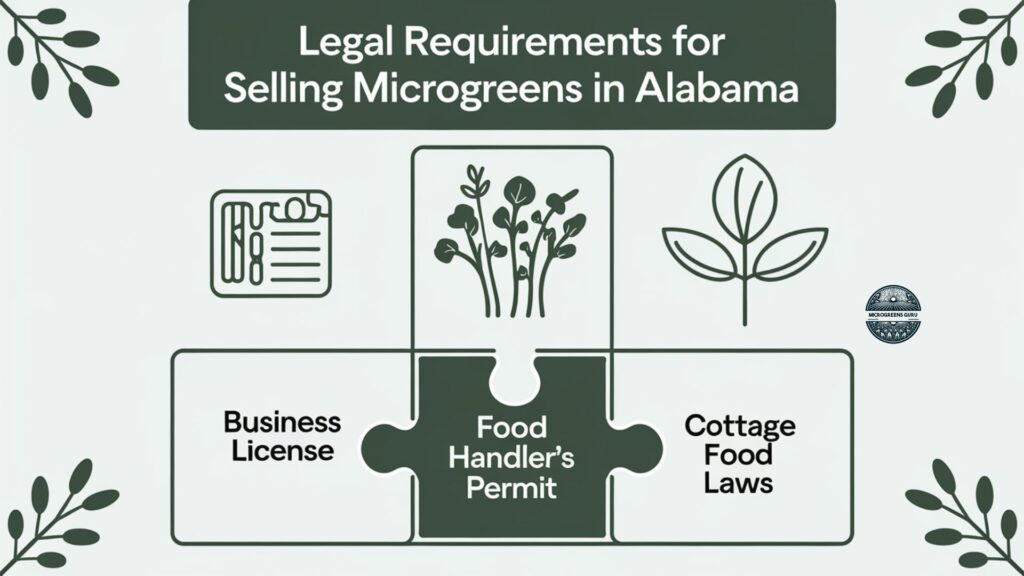
Legal Requirements for Selling Microgreens
Navigating the legal landscape is a crucial part of starting and running your microgreens business in Alabama. The requirements can vary depending on the scale of your operation and your sales channels. Let’s break down the key legal considerations you need to be aware of.
Small Growers vs. Commercial Outlets
In Alabama, the regulations for selling microgreens can vary depending on the scale of your operation. Understanding where you fit in this spectrum is the first step in ensuring compliance.
Small growers in Alabama might be able to operate under cottage food laws, which allow for the production and sale of certain non-potentially hazardous foods made in home kitchens. These laws are designed to support small-scale producers and make it easier for them to enter the market.
On the other hand, commercial outlets typically need to comply with more stringent regulations. These might include obtaining a food processing license, adhering to Good Manufacturing Practices (GMPs), and possibly registering with the FDA under the Food Safety Modernization Act (FSMA).
Here’s a quick comparison:
Small Growers:
- May operate under cottage food laws
- Limited to direct-to-consumer sales
- May have a cap on annual sales
- Less stringent facility requirements
Commercial Outlets:
- Need to comply with more comprehensive regulations
- Can sell to a wider range of customers, including retailers and restaurants
- No cap on sales volume
- More stringent facility and processing requirements
It’s important to note that microgreens aren’t specifically mentioned in Alabama’s cottage food laws, so you’ll need to check with your local health department for clarification on how they classify microgreens.
Cottage Food Laws and Regulations
As of 2021, Alabama’s cottage food laws have become more favorable for small producers. Here are the key points you need to know:
- Unlimited sales: Alabama removed the previous $20,000 annual sales cap for cottage food producers.
- Allowed sales channels: You can sell directly to consumers at farmer’s markets, from your home, online, and through phone orders.
- Restricted venues: Sales to restaurants, grocery stores, or other retail outlets aren’t permitted under these laws.
- Labeling requirements: Your products must be labeled with specific information, including a statement that they’re not inspected by the health department.
While microgreens aren’t explicitly listed as a cottage food, they might fall under the category of “dried herbs” or “dried vegetables.” Again, it’s best to confirm with your local health department.
If you qualify under cottage food laws, you’ll benefit from less stringent regulations, but you’ll also be limited in your sales channels. As your business grows, you may need to transition to a fully licensed operation to expand your market.
Licensing and Permits
Regardless of your operation’s size, you’ll likely need a basic business license from your local municipality. This is typically the first step in legitimizing your microgreens business.
Depending on where and how you plan to sell your microgreens, you might also need:
- A food handler’s permit from your county health department: This demonstrates that you understand basic food safety principles.
- Vendor permits for farmers’ markets: Each market may have its own requirements, so check with the market managers where you plan to sell.
- An agricultural or nursery license: While this isn’t typically required for small-scale microgreens production, it’s worth checking with the Alabama Department of Agriculture and Industries if you’re planning a larger operation.
Remember, requirements can vary by county and city, so it’s always best to check with your local authorities. Don’t hesitate to reach out to your local Small Business Development Center or the Alabama Department of Agriculture and Industries for guidance. They can help you navigate the licensing process and ensure you’re fully compliant.
Food Safety Regulations
Food safety is paramount when selling any food product, including microgreens. While small growers might be exempt from some regulations, it’s always best practice to follow good food safety protocols.
Here are some key food safety practices to implement:
- Water quality: Use clean, potable water for irrigation. If you’re using well water, have it tested regularly.
- Growing environment: Maintain a clean, sanitized growing area. This includes regularly cleaning trays, tools, and surfaces.
- Personal hygiene: Implement strict hand-washing protocols and use gloves when handling microgreens.
- Proper storage: Store harvested microgreens at the correct temperature (usually around 40°F) to maintain freshness and prevent bacterial growth.
- Packaging: Use food-grade packaging materials and handle microgreens gently to prevent bruising.
- Record-keeping: Keep detailed records of your growing and harvesting processes. This can help you identify and address any issues that arise.
For larger operations, compliance with the FDA’s Food Safety Modernization Act (FSMA) might be necessary. This involves implementing more comprehensive food safety measures and possibly undergoing inspections. Key aspects of FSMA compliance include:
- Developing a food safety plan
- Implementing preventive controls
- Conducting hazard analyses
- Establishing monitoring procedures
- Maintaining detailed records
Even if you’re not required to comply with FSMA, following these principles can help ensure the safety of your product and build trust with your customers.
Production Requirements
When it comes to production, Alabama doesn’t have specific requirements for microgreens. However, following Good Agricultural Practices (GAP) is advisable. This includes:
- Seed selection: Use clean, high-quality seeds from reputable suppliers. Consider using organic seeds if you’re targeting the organic market.
- Growing medium: Use a sterile growing medium to prevent contamination. Many growers use a mix of coconut coir, perlite, and vermiculite.
- Lighting: Ensure your microgreens receive adequate light. This could be natural sunlight or artificial grow lights.
- Watering: Implement a consistent watering schedule. Bottom watering can help prevent mold growth.
- Air circulation: Good airflow can prevent mold and promote stronger stems. Consider using fans in your growing area.
- Harvesting: Use clean, sharp tools for harvesting. Handle microgreens gently to prevent bruising.
- Post-harvest handling: Cool microgreens quickly after harvest and maintain the cold chain during storage and transportation.
Remember, the key is to produce safe, high-quality microgreens that will keep your customers coming back for more. Consistently high-quality products will help you build a reputation as a reliable microgreens supplier in Alabama.
Financial Aspects
Understanding the financial aspects of your microgreens business is crucial for long-term success. From pricing strategies to tax considerations, let’s explore the key financial factors you need to consider when selling microgreens in Alabama.
Pricing and Profit Potential
Pricing your microgreens right is crucial for the success of your business. You need to find a balance between being competitive in the market and ensuring profitability. Here’s a breakdown of pricing and profit potential in Alabama:
Wholesale pricing:
- Microgreens typically sell for $25-$40 per pound wholesale in Alabama.
- A standard 1020 tray can yield 8-12 ounces of microgreens.
- Potential earnings per tray: $12.50-$18.75 at wholesale prices.
Retail pricing:
- Retail prices are often 2-3 times the wholesale price.
- You might sell microgreens for $2-$4 per ounce at farmers markets or directly to consumers.
- A 1020 tray could potentially earn $32-$64 at retail prices.
Production costs:
- Seed costs: $1-$3 per tray, depending on the variety.
- Growing medium: $0.50-$1 per tray.
- Electricity and water: Approximately $0.50-$1 per tray.
- Packaging: $0.50-$1 per tray.
- Labor: This varies, but budget for about $1-$2 per tray.
Total production costs typically range from $3-$5 per tray.
Profit potential:
- Wholesale: $8.50-$14.75 per tray
- Retail: $28-$59 per tray
These figures are estimates and can vary based on factors like your specific location in Alabama, the microgreen varieties you’re growing, and your production efficiency. As you gain experience, you’ll likely be able to reduce costs and increase yields, improving your profit margins.
Consider implementing a tiered pricing strategy:
- Bulk discounts for larger orders
- Premium pricing for specialty or hard-to-grow varieties
- Subscription services for regular customers
Remember, while profit is important, don’t compromise on quality. Consistently high-quality microgreens will help you build a loyal customer base and command higher prices over time.
Tax Considerations
As a microgreens grower in Alabama, you’ll need to consider several tax obligations. Understanding these from the start can help you avoid surprises and plan effectively.
- Sales tax:
- Alabama’s state sales tax rate is 4%, plus any applicable local taxes.
- You’re responsible for collecting and remitting sales tax on your microgreens sales.
- Some agricultural products may be exempt, so check with the Alabama Department of Revenue for specific guidelines.
- Income tax:
- This varies depending on your business structure.
- Sole proprietors and partnerships typically report business income on personal tax returns.
- The Alabama individual income tax rates range from 2% to 5%, depending on your income level.
- Business Privilege Tax:
- This applies to most business entities in Alabama.
- The minimum tax is $100, but it can be higher based on your net worth.
- Self-employment tax:
- If you’re self-employed, you’ll need to pay self-employment tax (15.3% as of 2023) on your net earnings.
- Estimated taxes:
- As a business owner, you may need to make quarterly estimated tax payments.
- Deductions:
- Keep track of all business expenses, as these can be deducted from your taxable income.
- Common deductions for microgreens businesses include seeds, growing supplies, equipment, and marketing expenses.
- Agricultural tax benefits:
- Depending on the scale of your operation, you might qualify for certain agricultural tax benefits.
- These could include deductions for soil and water conservation expenses or special depreciation rules for farm equipment.
It’s always a good idea to consult with a tax professional familiar with Alabama’s agricultural tax laws. They can help ensure you’re meeting all your obligations and taking advantage of any available tax benefits.
Consider using accounting software to track your income and expenses throughout the year. This will make tax time much easier and help you make informed financial decisions for your microgreens business.
Remember, tax laws can change, so stay informed and don’t hesitate to seek professional advice as your business grows.
Labeling and Packaging
Proper labeling and packaging are crucial aspects of selling microgreens in Alabama. They not only ensure compliance with regulations but also play a significant role in marketing your product and maintaining its quality. Let’s explore the requirements and best practices for labeling and packaging your microgreens.
Labeling Requirements
Labeling your microgreens correctly is not just about following the law; it’s about building trust with your customers and differentiating your product in the market. Here are the key components your labels should include:
- Product name: Clearly state “Microgreens” along with the specific variety (e.g., “Radish Microgreens”).
- Net weight: Provide an accurate statement of the net weight in both metric and English units.
- Producer information: Include your business name and address.
- Ingredients: List all ingredients. For most microgreens, this will simply be the seed variety.
- Date of packaging: This helps customers know how fresh the product is.
- Storage instructions: Advise customers on how to store the microgreens for maximum freshness.
- Nutritional information: While not always required, including basic nutritional facts can be a selling point.
If you’re operating under cottage food laws in Alabama, you’ll also need to include these statements in a minimum 10-point font:
- “This food is not inspected by the health department”
- “This product may contain allergens”
For organic microgreens: If you’re selling certified organic microgreens, you must include the USDA Organic seal and the certifying agency’s name.
Remember, your label is often the first point of contact between your product and potential customers. Make it attractive and informative, but ensure all required information is clearly visible.
Packaging Requirements
While Alabama doesn’t have specific packaging requirements for microgreens, using food-grade materials is a must. Your packaging should:
- Maintain freshness: Choose packaging that helps maintain the optimal temperature and humidity for microgreens.
- Allow for proper air circulation: Some airflow can help prevent condensation and mold growth.
- Protect the delicate microgreens: Your packaging should shield the greens from damage during transport and handling.
- Showcase the product: Clear packaging allows customers to see the quality of your microgreens.
- Be environmentally friendly: Consider using biodegradable or recyclable materials. Many customers appreciate eco-friendly packaging options.
- Be appropriately sized: Offer different package sizes to cater to various customer needs, from individual consumers to restaurants.
Popular packaging options for microgreens include:
- Clear clamshell containers: These protect the delicate greens and allow customers to see the product.
- Resealable plastic bags: A cost-effective option that can work well for larger quantities.
- Compostable containers: These appeal to environmentally conscious consumers.
- Modified atmosphere packaging: For longer shelf life, especially if selling to grocery stores.
Remember to consider the environmental conditions in Alabama when choosing your packaging. Our humid climate can affect the shelf life of microgreens, so packaging that helps control moisture is crucial.
Regardless of the packaging you choose, always ensure it’s clean and food-safe. Proper packaging not only preserves the quality of your microgreens but also reflects the professionalism of your business.
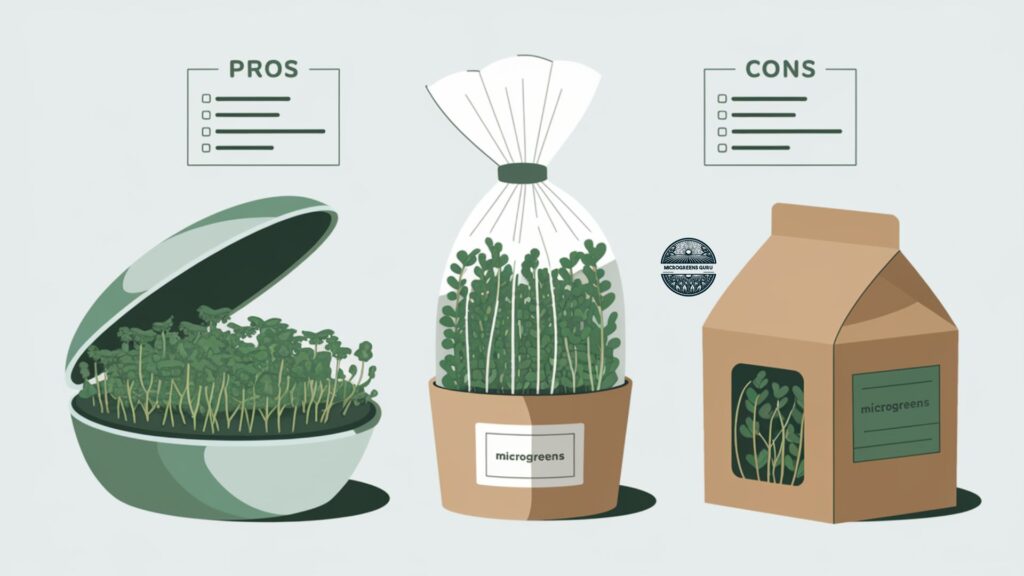
Sales and Marketing
Success in the microgreens business isn’t just about growing great produce; it’s also about effectively selling and marketing your product. In Alabama, there are various avenues to explore and strategies to implement. Let’s dive into the key aspects of sales and marketing for your microgreens business.
Sales Venues and Restrictions
Where you can sell your microgreens in Alabama depends on your licensing and the scale of your operation. Let’s explore the various options:
- Farmers’ Markets:
- A great starting point for many microgreens growers.
- You’ll need to comply with market-specific rules and possibly obtain a vendor permit.
- Benefits include direct customer interaction and community engagement.
- Direct from Home:
- If operating under cottage food laws, you can sell directly from your home.
- Consider setting up a small farm stand or offering scheduled pick-ups.
- Online Sales:
- Alabama allows online sales within the state for cottage food producers.
- Set up an e-commerce website or use platforms like Facebook Marketplace or Instagram.
- Ensure you have a system for safe delivery or pick-up.
- Community Supported Agriculture (CSA):
- Offer microgreens as part of a CSA box.
- This can provide a steady income stream and help build a loyal customer base.
- Restaurants and Cafes:
- A potentially lucrative market, but usually requires scaling beyond cottage food laws.
- Build relationships with local chefs who appreciate fresh, local produce.
- Grocery Stores and Co-ops:
- Another option for larger operations.
- You’ll need to meet their packaging and labeling requirements.
- Food Service Distributors:
- For large-scale operations, working with distributors can help you reach a wider market.
Remember, if you’re operating under cottage food laws, you’re limited to direct-to-consumer sales. As your business grows, you may need to obtain additional licenses to expand your sales channels.
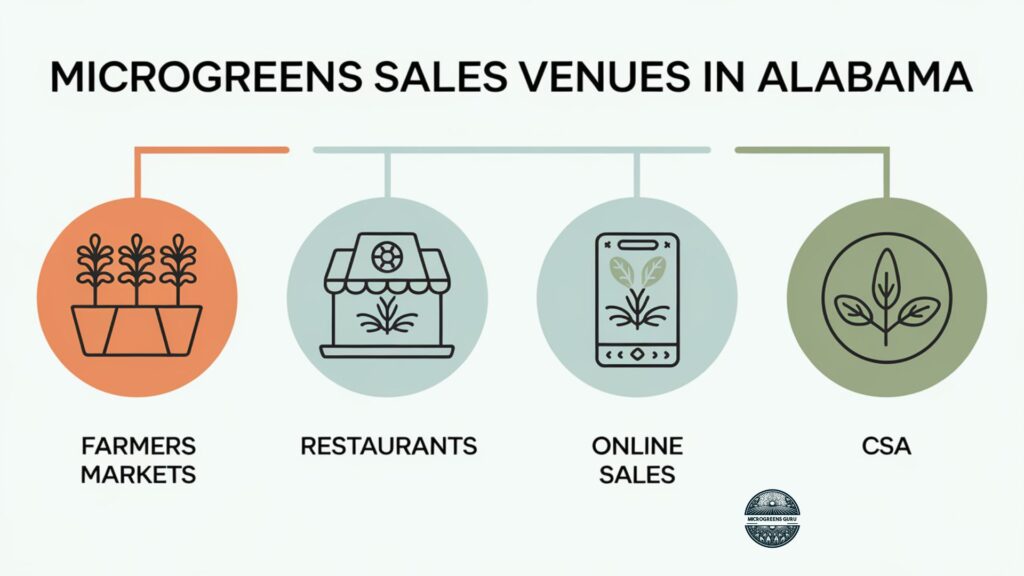
Marketing Restrictions
While marketing your microgreens, it’s important to stay within legal and ethical boundaries. Here are some key points to keep in mind:
- Health Claims:
- Be cautious about making specific health claims.
- Stick to general statements about the nutritional content of microgreens.
- Any health claims must comply with FDA regulations.
- Organic Labeling:
- Only use the term “organic” if you’re certified.
- If you use organic practices but aren’t certified, you can say “grown using organic methods” instead.
- Local and Fresh:
- Emphasize the local and fresh nature of your product, which is highly valued in Alabama.
- Testimonials:
- If using customer testimonials in your marketing, ensure they’re genuine and not misleading.
- Pricing Information:
- Be clear and honest about your pricing in all marketing materials.
Focus your marketing efforts on the unique selling points of your microgreens:
- Freshness and local production
- Intense flavors and vibrant colors
- Nutritional benefits
- Versatility in cooking
Utilize various marketing channels to reach your target audience:
- Social Media:
- Platforms like Instagram and Facebook are great for showcasing your colorful microgreens.
- Share growing processes, recipes, and customer testimonials.
- Local Food Blogs and Influencers:
- Collaborate with local food bloggers or social media influencers to reach more customers.
- Cooking Demonstrations:
- Offer demos at farmers’ markets or local events to show how to use microgreens.
- Email Marketing:
- Build an email list to keep customers informed about your products and offers.
- Website:
- Create a professional website with information about your microgreens and where to buy them.
- Local Media:
- Reach out to local newspapers, radio stations, or TV channels for feature stories.
Remember, Alabamians love supporting local businesses. Emphasize your roots in the community and how your microgreens business contributes to the local food scene.
Consumer Education
Educating your customers about microgreens is not just a marketing strategy; it’s a crucial part of building a sustainable business. Many people in Alabama may not be familiar with microgreens or how to use them. Here’s how you can educate your consumers:
- Storage Instructions:
- Provide clear instructions on how to store microgreens for maximum freshness.
- Typically, this involves refrigeration at 32-40°F in a container that allows some airflow.
- Usage Ideas:
- Offer suggestions for using microgreens in cooking.
- Create and share simple recipes that incorporate microgreens.
- Highlight how microgreens can enhance the flavor and nutrition of everyday dishes.
- Nutritional Information:
- Educate customers about the nutritional benefits of microgreens.
- Compare the nutrient density of microgreens to their full-grown counterparts.
- Growing Process:
- Share information about how you grow your microgreens.
- Highlight any sustainable or unique practices you use.
- Variety Information:
- Educate customers about the different varieties you offer and their unique flavors.
- Suggest food pairings for each variety.
- Workshops and Classes:
- Consider offering workshops on growing or cooking with microgreens.
- This can create an additional revenue stream and build customer loyalty.
- Informational Brochures:
- Create brochures with FAQs, nutritional information, and recipe ideas.
- Distribute these at your point of sale or with each purchase.
- Video Content:
- Create short, informative videos about microgreens for social media or your website.
- In-Person Demonstrations:
- At farmers’ markets or events, offer tastings and demonstrate how to use microgreens in salads or as garnishes.
By educating your customers, you’re not just selling a product; you’re selling an experience and a lifestyle. This approach can lead to more satisfied customers, repeat business, and word-of-mouth referrals.
Microgreens in Alabama Quiz
Operational Considerations
Running a successful microgreens business in Alabama involves more than just growing and selling your product. There are several operational aspects you need to consider to ensure your business runs smoothly and complies with all relevant regulations.
Zoning Laws and Home-Based Business Regulations
If you’re planning to grow microgreens at home, it’s crucial to understand and comply with local zoning laws and home-based business regulations:
- Zoning Restrictions:
- Check your local zoning ordinances to ensure agricultural activities are allowed in your area.
- Some zones may have restrictions on commercial activities in residential areas.
- Home Occupation Permits:
- Most Alabama municipalities require a home occupation permit for operating a business from a residence.
- This permit ensures your business doesn’t negatively impact your neighborhood.
- Space Usage:
- There may be limits on how much of your home can be used for business purposes.
- For example, in Opelika, no more than 25% of the total floor area (up to 500 square feet) can be used for a home occupation.
- External Changes:
- Restrictions often apply to making external changes to your property for business purposes.
- This could include limitations on signage or additional structures.
- Customer Traffic:
- There may be restrictions on the number of customers allowed to visit your home-based business.
- Consider how you’ll manage pick-ups or deliveries without disrupting your neighbors.
- Equipment and Storage:
- Some cities, like Hoover, prohibit outside storage of supplies or materials for home-based businesses.
- Ensure your growing equipment and supplies can be stored appropriately.
- Vehicle Restrictions:
- There may be limits on the size and number of business-related vehicles you can have at your residence.
Always check with your local city or county planning department for the most up-to-date regulations specific to your area. As your business grows, you may need to consider moving to a commercial space to comply with regulations and expand your operation.

Insurance Requirements
While not always legally required, insurance is a smart investment for any business, including a microgreens operation in Alabama. Here are some types of insurance to consider:
- General Liability Insurance:
- Protects against third-party claims of bodily injury or property damage.
- Essential if customers visit your growing site or if you sell at farmers’ markets.
- Product Liability Insurance:
- Covers claims related to foodborne illnesses or injuries caused by your microgreens.
- Particularly important as you’re selling a food product.
- Property Insurance:
- Protects your equipment, inventory, and growing space from damage or theft.
- Consider additional coverage for specialized growing equipment.
- Business Interruption Insurance:
- Covers lost income if your operation is disrupted due to a covered event (e.g., natural disaster).
- Workers’ Compensation:
- Required if you have employees, even part-time.
- Covers medical expenses and lost wages if an employee is injured on the job.
- Commercial Auto Insurance:
- Necessary if you use a vehicle for business purposes, such as deliveries.
- Crop Insurance:
- While not common for microgreens, it might be worth exploring as your operation grows.
The specific insurance needs can vary based on your operation’s size, sales channels, and individual risk factors. Consult with an insurance professional familiar with agricultural and food businesses in Alabama to tailor a comprehensive coverage plan for your microgreens business.
Record-Keeping Requirements
Good record-keeping is essential for any business, but it’s particularly important in food production. Keeping detailed records can help you improve your processes, demonstrate compliance with regulations, and quickly address any food safety concerns that may arise.
Here are some key records to maintain:
- Production Logs:
- Planting dates
- Seed sources and lot numbers
- Harvest dates
- Yield data
- Any issues encountered during production (pests, diseases, etc.)
- Sales Records:
- Customer information
- Quantities sold
- Prices
- Date of sale
- Financial Records:
- Income and expenses
- Tax documents
- Payroll records (if you have employees)
- Food Safety Documentation:
- Cleaning and sanitization logs
- Water testing results
- Employee training records
- Temperature logs for storage areas
- Inventory Records:
- Seed inventory
- Growing supplies
- Packaging materials
- Traceability Records:
- Link between production batches and sales
- Crucial in case of a recall
- Licensing and Certification Documents:
- Business licenses
- Food handler’s permits
- Organic certification (if applicable)
- Marketing and Customer Feedback:
- Keep track of your marketing efforts and their results
- Record customer feedback and preferences
Consider using digital tools to streamline your record-keeping process. Many farm management software options are available that can help you track everything from production to sales.
Remember, good records are not just for compliance; they’re a valuable tool for improving your business. Regularly review your records to identify trends, optimize your processes, and make informed business decisions.
Inspection Protocols
While small-scale microgreens operations may not be subject to regular inspections, it’s best to be prepared. Larger operations, especially those selling to retail outlets or restaurants, may face more frequent inspections.
Here’s what you need to know about inspection protocols:
- Types of Inspections:
- Health Department inspections
- Food Safety Modernization Act (FSMA) inspections (for larger operations)
- Organic certification inspections (if applicable)
- Frequency:
- Varies depending on the scale of your operation and your sales channels
- Could be annual, bi-annual, or more frequent
- Areas Subject to Inspection:
- Growing areas
- Storage facilities
- Packaging areas
- Water sources
- Pest control measures
- Employee hygiene practices
- Record-keeping systems
- Preparation for Inspections:
- Keep your growing and packaging areas clean and organized
- Ensure all employees are trained in food safety practices
- Have all necessary records readily available
- Be prepared to demonstrate your growing and handling processes
- During the Inspection:
- Be cooperative and professional
- Ask questions if you’re unsure about any requirements
- Take notes on any suggestions or required improvements
- After the Inspection:
- Address any issues promptly
- Implement suggested improvements
- Keep a record of the inspection and your response
Even if you’re not subject to regular inspections, it’s a good practice to conduct self-inspections regularly. This can help you maintain high standards and be prepared for any surprise inspections.
Remember, inspectors are there to help ensure food safety, not to shut down businesses. View inspections as an opportunity to improve your processes and demonstrate your commitment to producing safe, high-quality microgreens.
By staying on top of these operational considerations, you’ll be well-positioned to run a successful and compliant microgreens business in Alabama. In the next sections, we’ll explore how to scale your business and navigate environmental and agricultural compliance.
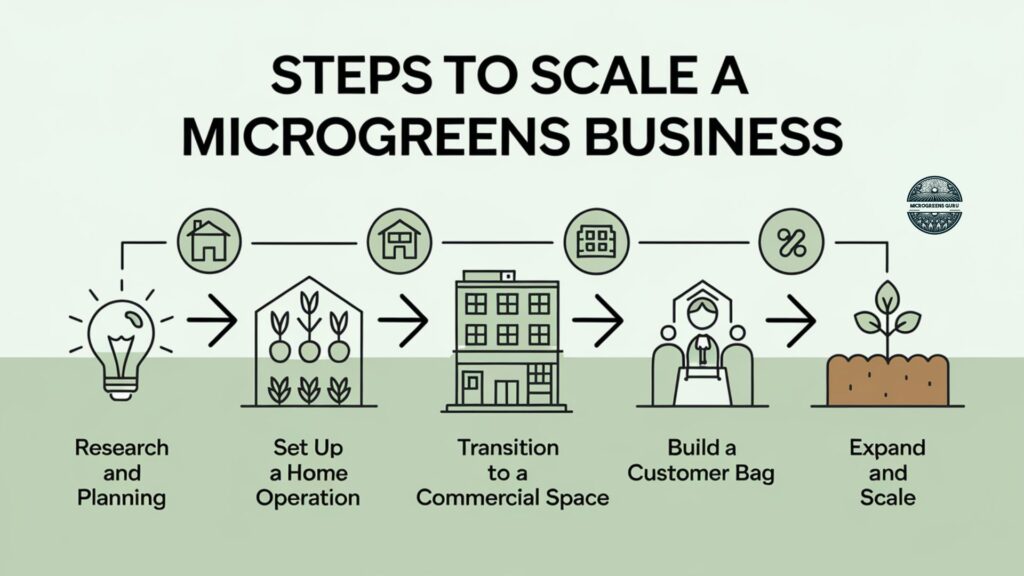
Scaling Your Microgreens Business
As your microgreens business in Alabama grows, you’ll face new challenges and opportunities. Scaling up requires careful planning and consideration of various factors. Let’s explore the key aspects of expanding your microgreens operation.
Interstate Commerce Regulations
If you’re considering selling your microgreens across state lines, you’ll need to navigate additional regulations:
- FDA Registration:
- Facilities that manufacture, process, pack, or hold food for consumption in the U.S. must register with the FDA.
- However, farms and retail food establishments are generally exempt from this requirement.
- Compliance with Destination State Regulations:
- Each state has its own regulations for incoming food products.
- Research the requirements for each state you plan to sell in.
- Labeling Requirements:
- Ensure your labels comply with federal regulations as well as any additional requirements of the destination states.
- Transportation Regulations:
- Adhere to food safety regulations during transport, including temperature control and proper packaging.
- Tax Considerations:
- Be prepared to collect and remit sales tax in states where you have a sales tax nexus.
Remember, while Alabama may have certain exemptions for small-scale producers, these may not apply when selling across state lines. Always check with the relevant authorities in both Alabama and the destination state to ensure compliance.
Employee Regulations
As your business grows, you may need to hire employees. Here are some key considerations:
- Employment Laws:
- Familiarize yourself with federal and Alabama labor laws.
- Alabama follows the federal minimum wage of $7.25 per hour.
- Workers’ Compensation:
- In Alabama, agricultural employers are not required to provide workers’ compensation insurance, but it’s often a good idea to do so.
- Payroll Taxes:
- You’ll need to withhold federal and state income taxes, as well as Social Security and Medicare taxes.
- Employee Training:
- Provide thorough training, especially in food safety practices.
- Occupational Safety and Health Administration (OSHA) Compliance:
- Ensure your workplace meets OSHA safety standards.
- Employment Verification:
- Use Form I-9 to verify the identity and employment authorization of each new employee.
Scaling Considerations
As you scale up your microgreens business, consider the following:
- Production Capacity:
- Invest in larger growing spaces and more efficient equipment.
- Implement systems to maintain consistent quality as you increase volume.
- Supply Chain Management:
- Develop relationships with reliable suppliers for seeds, growing media, and packaging materials.
- Consider bulk purchasing to reduce costs.
- Distribution:
- Explore new sales channels, such as food service distributors or grocery store chains.
- Invest in proper transportation equipment to maintain product quality during delivery.
- Technology:
- Implement farm management software to streamline operations.
- Consider automated systems for tasks like seeding and harvesting.
- Marketing:
- Expand your marketing efforts to reach new customer segments.
- Consider hiring a marketing professional or agency.
- Financial Management:
- Work with an accountant familiar with agricultural businesses.
- Consider seeking additional funding or investment for expansion.
- Legal Structure:
- As your business grows, you may want to reconsider your legal structure (e.g., moving from sole proprietorship to LLC or corporation).
Remember, scaling should be a gradual process. Grow at a pace that allows you to maintain product quality and customer satisfaction.
Environmental and Agricultural Compliance
As a microgreens grower in Alabama, it’s important to operate your business in an environmentally responsible manner and comply with relevant agricultural regulations. Let’s explore these aspects in detail.
Environmental Regulations
While there aren’t specific environmental regulations for microgreens in Alabama, it’s important to consider the environmental impact of your operation:
- Water Management:
- Use water efficiently to minimize waste.
- Implement a system to collect and reuse water if possible.
- Ensure runoff doesn’t contaminate local water sources.
- Waste Management:
- Compost plant waste when possible.
- Dispose of growing media and other waste responsibly.
- Recycle packaging materials where feasible.
- Energy Efficiency:
- Use energy-efficient grow lights and climate control systems.
- Consider renewable energy sources like solar panels.
- Pest Management:
- Use integrated pest management techniques to minimize chemical use.
- If using pesticides, ensure they’re approved for use on edible crops and follow all application guidelines.
- Soil and Growing Media:
- If using soil, implement practices to prevent erosion and maintain soil health.
- For hydroponic systems, properly dispose of used nutrient solutions.
While these practices may not be legally required, they demonstrate your commitment to sustainability and can be a strong selling point for environmentally conscious consumers.
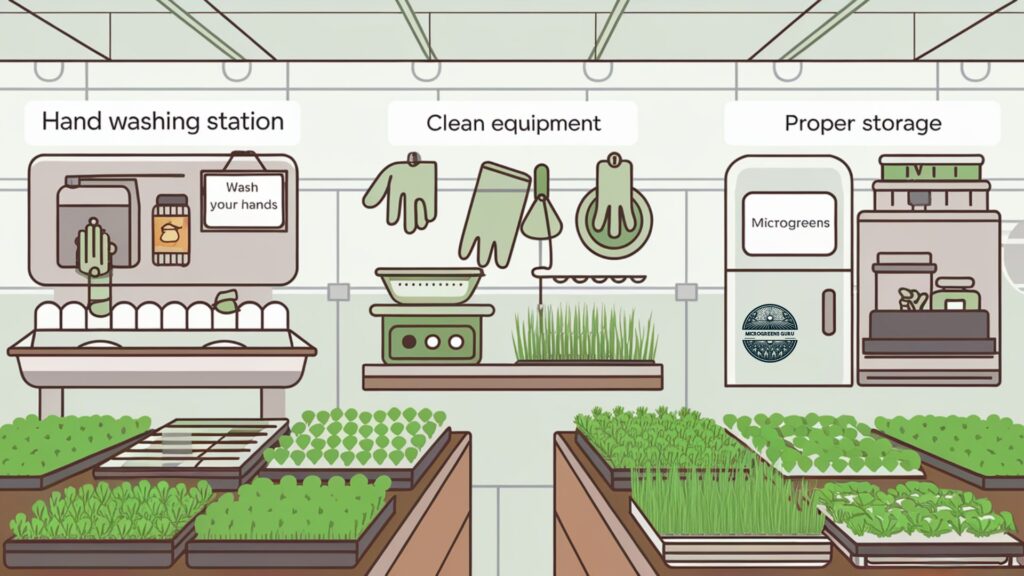
Compliance with Food Safety Modernization Act (FSMA)
The FSMA has significant implications for produce growers, including microgreens producers. Here’s what you need to know:
- Covered vs. Exempt Farms:
- Farms with less than $25,000 in annual produce sales are generally exempt from the Produce Safety Rule.
- Larger operations need to comply with more stringent requirements.
- Key Requirements:
- Agricultural water quality
- Biological soil amendments
- Domesticated and wild animals
- Worker training and health and hygiene
- Equipment, tools, and buildings
- Preventive Controls:
- Identify potential hazards in your operation.
- Implement preventive controls to minimize these risks.
- Record Keeping:
- Maintain detailed records of your food safety practices.
- Inspections:
- Be prepared for FDA inspections to verify compliance.
Even if your operation is exempt, following FSMA guidelines can help ensure the safety of your product and build trust with customers.
Organic Certification Process (if applicable)
If you’re interested in selling certified organic microgreens, you’ll need to go through the USDA organic certification process:
- Transition Period:
- Your growing area must be free from prohibited substances for 3 years before certification.
- For indoor or container systems, this period may be shorter.
- Organic System Plan:
- Develop a plan detailing your production practices, including seed sources, growing methods, and pest management strategies.
- Choose a Certifier:
- Select a USDA-accredited certifying agent.
- The Alabama Department of Agriculture and Industries offers organic certification services.
- Application and Inspection:
- Submit your application and organic system plan to the certifier.
- An inspector will visit your operation to verify compliance with organic standards.
- Review and Certification:
- The certifier reviews the inspection report and your application.
- If approved, you’ll receive your organic certificate.
- Annual Renewal:
- Organic certification must be renewed annually, including updated paperwork and inspections.
- Ongoing Compliance:
- Maintain detailed records of your organic practices.
- Use only approved substances in your operation.
Remember, while organic certification can add value to your product, it also involves additional costs and record-keeping requirements. Carefully consider whether the benefits outweigh the costs for your specific operation.
Support and Resources
Running a microgreens business in Alabama doesn’t mean you have to go it alone. There are numerous resources available to support your venture. Let’s explore some of the key support systems and resources you can tap into.
Local Resources and Support
Alabama offers several resources for microgreens growers:
- Alabama Cooperative Extension System (ACES):
- Offers educational programs and expert advice on agricultural practices.
- Provides resources on pest management, soil health, and marketing strategies.
- Website: www.aces.edu
- Alabama Department of Agriculture and Industries:
- Provides information on regulations and market development.
- Offers resources on food safety and organic certification.
- Website: agi.alabama.gov
- Alabama Sustainable Agriculture Network (ASAN):
- Offers workshops and networking opportunities for sustainable farmers.
- Provides resources on sustainable growing practices.
- Website: asanonline.org
- Alabama Farmers Market Authority:
- Supports and promotes farmer’s markets across the state.
- Offers resources for selling at farmer’s markets.
- Website: fma.alabama.gov
- Alabama Small Business Development Center Network:
- Provides free consulting services to small businesses.
- Offers workshops on business planning, marketing, and financial management.
- Website: asbdc.org
State Agricultural Extension Offices
Your local extension office can be a valuable resource for information on growing techniques, pest management, and local market opportunities. Here are some ways they can help:
- Technical Assistance:
- Get expert advice on growing techniques specific to microgreens.
- Learn about pest and disease management strategies.
- Soil Testing:
- Many extension offices offer soil testing services, which can be valuable if you’re growing in soil.
- Workshops and Training:
- Attend educational programs on various aspects of agriculture and business management.
- Market Research:
- Get information on local market trends and opportunities.
- Networking:
- Connect with other growers and industry professionals.
To find your local extension office, visit the Alabama Cooperative Extension System website and search by county.
Don’t hesitate to reach out to these resources with questions. They’re there to support Alabama’s agricultural community, including innovative growers like yourself.
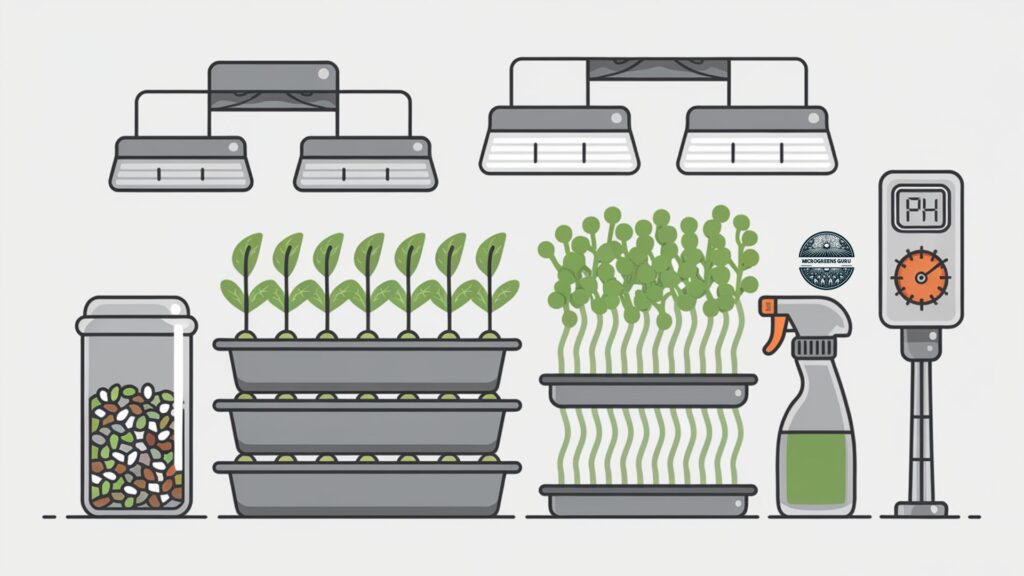
Product Recommendations
To help you get started or upgrade your microgreens operation, here are some products I’ve found helpful:
- 1020 Trays with Holes: These standard-sized trays are perfect for growing microgreens and fit well on most shelving units. They provide good drainage and are easy to clean and sanitize between crops.
- Organic Seed Mix: A blend of organic seeds can give you a variety of microgreens to experiment with. Look for mixes that include popular varieties like broccoli, radish, and kale. I trust the seeds that I get from True Leaf Market. I have never had an issue with them.
- Full Spectrum LED Grow Lights: These can help ensure consistent growth, especially if you’re growing indoors. Look for lights with adjustable intensity and a spectrum that promotes healthy plant growth.
- Digital pH Meter: Monitoring your soil or growing medium’s pH can help optimize your microgreens’ growth. A reliable digital pH meter is a worthwhile investment.
- Food-Grade Spray Bottles: These are essential for gentle watering of your delicate microgreens. Look for bottles with adjustable nozzles for fine mist spraying.
These products can help streamline your microgreens production and potentially improve your yields. Remember, investing in quality equipment can pay off in the long run with healthier plants and better harvests.
Further Reading
To deepen your understanding of microgreens and help you succeed in your Alabama microgreens business, check out these articles:
- Best Microgreens to Sell: Discover the Top Varieties Consumers Can’t Resist – This article can help you choose the most profitable microgreens to grow in Alabama’s market.
- How Much Can You Make Selling Microgreens? Explore the Financial Upside of Green Thumbs – Get insights into the potential profitability of your microgreens business.
- Decoding FDA Guidelines for Microgreens: A Comprehensive Guide for Growers – Understanding FDA guidelines is crucial for ensuring compliance and food safety.
- Do I Need a License to Sell Microgreens? Dispelling Myths, Unveiling Truths – This article can clarify licensing requirements for microgreens businesses.
- Microgreens Packaging Ideas: Innovative Ways to Make Your Greens Stand Out – Learn how to package your microgreens effectively for maximum appeal and freshness.
These resources cover various aspects of selling microgreens, from choosing profitable varieties to understanding regulations and packaging, which complement the information in this guide about selling microgreens in Alabama.
Frequently Asked Questions About Selling Microgreens In Alabama
As you venture into selling microgreens in Alabama, you might have some questions. Here are answers to some of the most frequently asked questions:
Can you sell produce in Alabama?
Yes, you can sell produce in Alabama. Anyone growing produce can sell on the market. In Alabama, the sheds at the front of many markets (1, 8, and 9) are often reserved for Alabama growers with an Alabama Growers Permit. Out-of-state produce is typically sold in designated areas, such as the Northend shed located at the back of some markets.
Do you need a license to sell plants from home in Alabama?
The licensing requirements depend on the type of plants you’re selling. If you’re selling live plants with a root system and in soil, you are required to have a nursery dealer certificate. However, if you’re only selling cut flowers or harvested microgreens, you typically don’t need this specific license. Always check with your local authorities for the most up-to-date requirements.
How do you get a growers permit in Alabama?
To obtain a growers permit in Alabama, follow these steps:
- Contact your county Extension office to request a growers permit.
- The office will then send the permit to the Alabama Department of Agriculture and Industries’ Farmers Market Authority, which will keep a record of the permit.
- Share a copy of the growers permit with the farmers market manager where you wish to sell.
Are there specific regulations for selling microgreens in Alabama?
While there aren’t specific regulations for microgreens in Alabama, they generally fall under broader produce and food safety regulations. Depending on the scale of your operation, you may need to comply with cottage food laws, obtain a business license, or adhere to FDA guidelines. It’s best to check with your local health department and the Alabama Department of Agriculture and Industries for the most current requirements.
Do I need to register my microgreens business with the FDA?
If you’re a small grower selling directly to consumers within Alabama, you may not need to register with the FDA. However, if you’re selling across state lines or to retail establishments, registration may be required. Farms with less than $25,000 in annual produce sales are generally exempt from certain FDA regulations under the Food Safety Modernization Act.
Can I sell microgreens at farmer’s markets in Alabama?
Yes, you can sell microgreens at farmers markets in Alabama. Many markets welcome local producers. You’ll likely need a vendor permit from the specific market, and you should ensure you’re following all local health department guidelines for food safety and labeling.
What are the best microgreens to grow and sell in Alabama?
While preferences can vary, some popular microgreens in Alabama include:
- Radish microgreens (quick-growing and spicy)
- Sunflower microgreens (nutty flavor, popular among customers)
- Pea shoots (sweet taste, grow well in cooler seasons)
- Broccoli microgreens (nutrient-dense and mild flavored)
- Cilantro microgreens (popular in various cuisines)
Consider experimenting with different varieties to see what grows best in your specific conditions and what your customers prefer.
How should I price my microgreens in Alabama?
Pricing can vary depending on your location, production costs, and target market. In Alabama, microgreens typically sell for $25-$40 per pound wholesale, with retail prices often being 2-3 times higher. Consider your costs, market demand, and competitors’ prices when setting your prices.
Remember, laws and regulations can change, so it’s always best to verify current requirements with local authorities. If you have more specific questions about your microgreens business in Alabama, don’t hesitate to reach out to local agricultural extension offices or small business development centers for personalized advice.

Final Thoughts
Selling microgreens in Alabama offers a unique opportunity to tap into the growing demand for fresh, locally-grown, nutrient-dense foods. While there are regulations to navigate and challenges to overcome, the potential rewards – both financial and in terms of contributing to your community’s health – can be significant.
Remember, success in the microgreens business comes down to producing a high-quality product consistently, understanding your market, and building strong relationships with your customers. Whether you’re starting small with a home-based operation or planning a larger commercial venture, there’s room for growth in Alabama’s microgreens market.
As you embark on this green journey, don’t hesitate to leverage the resources available to you, from local agricultural extensions to online communities of microgreen growers. And most importantly, enjoy the process! There’s something truly rewarding about nurturing these tiny greens and sharing their benefits with others.
Feedback and Questions
I’d love to hear about your experiences selling microgreens in Alabama.
Have you encountered any unexpected challenges?
What strategies have worked well for you?
Your insights could be incredibly valuable to others just starting their microgreens journey.
If you have any questions about the content of this article or need further guidance, please don’t hesitate to reach out. You can leave a comment below or contact us through our website. We’re here to support you every step of the way in your microgreens venture.
Remember, in the world of microgreens, good things really do come in small packages.
So why not start your Alabama microgreens business today?
You might just find yourself, like me, falling in love with these tiny green superheroes.

Cal Hewitt is the Founder and Lead Cultivator at Microgreens Guru, a website dedicated to empowering individuals to grow, consume, and potentially sell nutrient-dense microgreens. With 5 years of hands-on experience in microgreens cultivation, Cal brings a unique analytical perspective to the world of urban agriculture. He specializes in optimizing growth techniques for various microgreen varieties, while also focusing on sustainable and cost-effective growing methods. Cal’s passion for microgreens, ignited by a personal health journey, drives him to continuously explore and share innovative approaches to microgreens cultivation. His practical experience, combined with his commitment to education through his website and upcoming book, ensures that Microgreens Guru remains a valuable resource for both novice and experienced growers alike.

